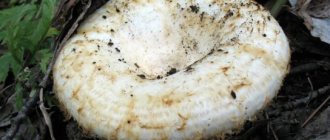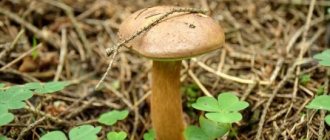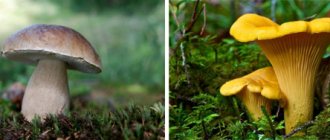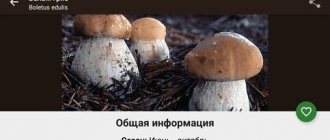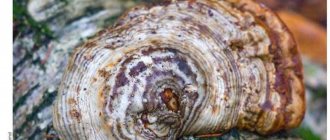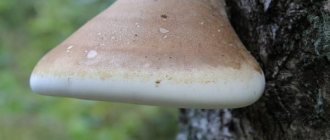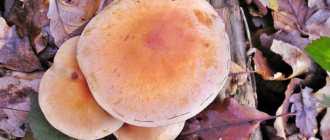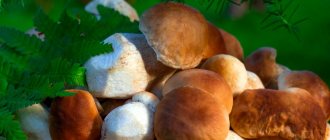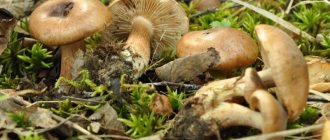Names of edible mushrooms with red caps
Mushrooms with red caps can be found in almost any forest. And they look very beautiful and unusual. Some species with red caps can be used in cooking without fear.
Redhead
Red boletus, or redhead, is an edible mushroom from the group of laticifers, which got its name due to its ability to form mycorrhiza with aspen. Also, the color of its cap is similar to the shade of aspen leaves.
Young fruits have a spherical cap, which is located on a massive, thick stalk. When the fruit ripens, the cap opens and its edges diverge. In mature mushrooms it is round and red or brick-colored.
The size of the leg is 5 cm in diameter. At first it is gray, then brownish. Below you can usually notice a pronounced thickening.
On a note! Although redcap is most often found in aspen areas, it also bears fruit near other deciduous trees. In most cases they appear near young trees. And some representatives of this group are found even in the tundra.
Marsh Russula
Swamp russula is also called floater. She is not afraid of any weather conditions - neither rain nor drought.
This species lives in Eurasia and North America. Fruits from the second half of July to the end of September. Grows in swamps and other areas with damp, wet soil.
The mushroom has a bright red color, for which it received its second name - float. Like, you can see it from afar, like a float on the water. The center of the fruit's cap is especially distinct and bright. Pinkish inclusions appear along the edges.
The stem of the mushroom is round and has a cavity inside. Its height is 4-10 cm, and its diameter is approximately 2 cm. It is smooth and dry to the touch, white in color. The pulp is elastic, hard, dense. It has no distinct odor, but has a bitter taste. It is usually used in food after marinating or salting.
Rules, conditions and storage periods
The main requirement for the preservation of champignons: fresh mushrooms collected or purchased should not be washed. The lamellar spore-bearing layer has a loose structure. It instantly absorbs water and distributes moisture throughout the entire body of the product.
The shelf life of mushrooms depends on the processing method and condition:
- fresh at room temperature - from 12 to 18 hours;
- in the refrigerator (on the vegetable shelf) - from 3 to 6 days;
- in the freezer raw - 6–9 months;
- frozen boiled - up to 6 months;
- dry - from 12 to 18 months;
- canned at home - maximum 6 months;
- factory pickled - up to 12 months (due to the content of preservatives).
There are rules for the conditions and methods of storing mushrooms:
- do not buy a product if it has been on the counter for more than 72 hours;
- keep in a tightly closed container or vacuum bag to ensure minimal access to oxygen (additionally, manipulation does not allow the mushrooms to dry out);
- the optimal temperature in the refrigerator is + 5–7°C, but it is better from 0 to + 2°C;
- Change the packaging once every 2-3 days (when kept in a cold place, condensation is created in the bag), first let the mushrooms dry a little;
- champignons stored without containers dry out quickly;
- It is permissible to keep fresh, boiled, fried champignons in the freezer (fresh ones are not washed, but only cleaned of dirt, fried ones are placed on a paper towel to get rid of fat);
- control the temperature in the freezer - it should not be higher than -18°C.
An excellent storage option is dried mushrooms. There are two ways:
- Cut the champignons into thin slices/cubes, place on a baking sheet, and keep in the oven at a temperature of + 45–50° until the moisture has completely evaporated.
- Thread cut slices or whole mushrooms onto a thread and hang them in the open sun. Bring it indoors at night. When the champignons begin to break well, they are ready.
It is convenient to grind dry semi-finished products and store them in powder form (for sauces, soups).
Experienced mushroom pickers talk about the storage requirements for champignons in the video:
How to prolong the freshness of a product?
In some cases, when a person consumes champignons raw (as a source of nutrients in dietary nutrition), there is a need to prolong their freshness. There are several options:
- Make a saline solution in a saucepan (for 1 liter of water - 2-3 tablespoons of salt), place the mushrooms in the container, boil for 2-3 minutes after boiling (the nutrients do not have time to evaporate), squeeze out the water and freeze.
- When storing in the refrigerator, place dry (not washed) mushrooms in a plastic container and cover with a natural fabric towel on top.
- Place the product in portions in canvas bags, place the blanks in a container with a closed lid.
Before carrying out manipulations to prolong freshness, you need to properly prepare the champignons for storage:
- cut off the edge of the leg with a sharp knife (try to avoid torn pieces);
- sweep away dirt (remains of soil) with a soft brush;
- if there are breaks or damaged areas, remove them;
- wipe with a dry soft cloth on all sides - do it carefully so as not to damage the body.
But, even if all conditions and requirements are met, it is unacceptable to keep champignons in the refrigerator for more than 7 days. After the expiration of the period, they begin to produce toxic substances.
Conditionally edible varieties
Conditionally edible mushrooms can be used for culinary purposes. But before that they must undergo thorough heat treatment.
Russula
The mushroom is often confused with red russula, which is edible. These fruits can only be distinguished after the spores have matured. In the stinging species, they color the inner cap part in an ocher shade. This mushroom is distributed throughout Russia.
Row yellow-red
Young rows have a convex cap, which becomes prostrate when ripe. Diameter – from 7 to 10 cm, but sometimes can reach 15 cm. Color – yellow-orange or yellow-red. There are small scales along the edges.
The stem is cylindrical, solid in a young mushroom, but becomes hollow with age. The pulp is juicy, thick, yellow. The taste of the mushroom is pleasant, the smell is slightly sour.
The yellow-red row can be found in coniferous forests. It prefers to grow on larch stumps, as well as in areas of dead wood, rubble, and floodplains. The mushroom bears fruit in July-September.
Beautiful, but inedible “plates”
Beautiful-looking mushrooms do not always live up to expectations, and sometimes they can unpleasantly surprise you with their taste. There are such “fakes” among lamellar inedible mushrooms:
- The breast is olive-black. The large cap of the young mushroom is cone-shaped and colored brown-green, then it straightens and becomes dark. The thick yellowish plates also darken with age. The squat, thick leg is brown and pitted. The pulp is bitter.
- Neutral milkweed (also known as oak or oak grass). Accordingly, it grows under oak trees, the cap is concave, red-brown, with a darker center and light rings. The leg is the same color. The pulp has an oily aroma and is bitter.
- Wolf's saw-leaf. Outwardly, it is very similar to oyster mushroom; yellow-brown caps in the form of growths are often found on trees. Sawfoil can be distinguished from the edible oyster mushroom by its blades: they are wide and have a jagged edge. The cap itself is covered with a felt skin with small warts. The pulp is very hard and bitter.
- Violin. The mushroom looks like a pepper mushroom: the cap with a funnel in the middle is covered with a velvety creamy skin, the edges are turned up. The short leg is white and the plates are sparse, while the milk mushroom has a longer leg and the plates under the cap are thick. The pulp is thin and pungent.
The inedibility of a mushroom is often revealed by its smell, so it wouldn’t hurt to give the treasure you find a good sniff.
What are poisonous red mushrooms called?
Many red mushrooms are completely inedible due to the large amount of toxins they contain.
Important!
They should never be eaten as food, as this can cause severe poisoning.
Russula Kele
The mushroom grows in young conifers and chooses moss as a soil. The cap of the fruit is reddish-purple, the leg is fleshy and massive, also has a purple tint. Despite their danger, the fruits have a pleasant spicy smell.
Red fly agaric
All mushroom pickers know that fly agaric is inedible. It is difficult to confuse it with other mushrooms, since it has a characteristic red cap with white dots. Grows among leaves, mosses and herbs.
The mushroom cap is 7-20 cm in size, has uneven edges and plates in the lower section. The leg is cylindrical, widened at the base. Its height is 6-15 cm, thickness - 1.5-2.5 cm.
This is interesting!
Forest fly agaric is widely used in folk medicine. With its help, tinctures and compresses are prepared for the treatment of arthritis and rheumatism.
Grille red
If you look at the clathrus, you can see that it has a very unusual, specific shape. Belongs to the Veselkov family and is listed in the Red Book of the Russian Federation.
Grows solitarily, prefers rotting wood or soil in deciduous forests. Loves mild and warm climates.
The young fruiting body is white and ovoid in shape, but it can also be spherical. The height is 5-10 cm, width - 5-7 cm. It is completely covered with thin shells.
The trellis has no legs as such. The pulp is spongy and has an unpleasant smell. The mushroom is completely unsuitable for consumption.
Use in cooking
Black and silver “ears” are similar in taste. They have a pleasant aroma and excellent taste. The dried parts are pre-soaked in cool water for 3-4 hours. The fruit body swells and increases in volume by 6-8 times.
Muer tastes more like gristle or jelly.
Cooks enjoy using this product to create original sauces and seasonings. They add it to soups, meat and fish dishes. “Ears” are suitable for filling pies, for pickling, frying or baking.
Irina Selyutina (Biologist):
When buying a package of muer at the supermarket, carefully read the instructions for preparing it. However, there are some points that are implied but not stated. Therefore, please note:
- First, the muer needs to be soaked so that the mushrooms from the compressed mass become individual specimens. Attention! Hot water cannot be used to soak muer, because... when exposed to high temperatures, you will end up with something slimy and unedible. Water slightly warmer than room temperature is suitable for this purpose.
- After soaking, they need to be sorted out, rinsed and filled with cold water for at least 12 hours. Although there are recipes that give other time frames for soaking.
Fans of this mushroom often recommend lightly salting the drained mushrooms and seasoning them with a small amount of 9% vinegar before cooking.
They are almost never used as independent dishes in European cuisine. But Asian cuisine is famous for a wide variety of dishes with the addition of these woody organisms. In Korea, they are fried with hot red pepper and other spices, sprinkled with fresh herbs and served as a main dish. “Silver ears” are well suited as a side dish to fried or boiled potatoes, rice and pork. Pairs well with fresh vegetables in salads.
Advice from experienced mushroom pickers
You may be interested in: How do edible talkers differ from false mushrooms? How many days after rain do mushrooms grow? Bitter mushroom: photo and detailed description
To avoid mistakes when picking mushrooms in the forest, you should not neglect the experience of experienced mushroom pickers. First of all, this concerns the question of how to distinguish edible fruits from poisonous ones.
- When picking mushrooms, you need to pay attention to their cap. In edible species it has a spongy structure. Of the poisonous specimens, only the satanic mushroom has a similar feature.
- Under no circumstances should you pick unfamiliar mushrooms, much less taste them!
- Before going into the forest, you should study in detail the types of edible fruits. You can make a reminder that will be convenient to carry with you.
- During “silent hunting”, leaves should be lifted with a stick, not with your hands. Even if the mushroom is poisonous, in this case its poison or spores will not be able to get on the skin.
All these rules must be strictly followed. They are relevant when collecting any types of mushrooms, no matter what color of cap and stem they have.
Benefit
After proper soaking, various dishes are prepared from mushrooms and stored for future use. Eating mushrooms has positive medicinal effects; the substances contained in nigella help remove kidney stones, improve immunity, have a positive effect on the nervous system, have antiviral and antibacterial properties, and inhibit the activity of mycobacteria and tubercle bacilli.
Similar species to Leccinum oxydabile
Blue boletus (Leccinum cyaneobasileucum) , a rare species, also grows under birch trees, but its flesh is blue near the base of the stem.
Blue boletus
The yellow-brown boletus (Leccinum versipelle) is edible, the cap is more orange and when bruised it turns blue-green at the base of the stem.
Yellow-brown boletus (Leccinum versipelle)
False doubles
There are a lot of milk mushroom doubles. The main ones are:
- creaky;
- spruce row;
- pig;
- white trumpet;
- toadstool;
- white milky.
All false representatives of the mushroom world differ from nigella, first of all, in color, although they are similar in general outline and height. They are white or have light shades, and their flesh, unlike the original, is looser and does not smell of anything, while nigella smells strong, pungent and pleasant. On a real black milk mushroom, when cut, purple juice always appears, and its stem is light.
Collection period
The ideal time for collection is August and September. Moreover, the best temperature for their active growth is up to +11°C. The maximum number of nigella appears after long rains, but collection should be timed to coincide with a dry and sunny day. Overripe mushrooms become tasteless, taste too bitter, and in addition, they become infested with worms and are eaten by forest slugs. The best specimen for collecting is a medium-sized milk mushroom, dense, strong and whole.
Important! When preparing nigella, do not roll up the lids. It is very important to provide air access to the product so that gas exchange occurs.
Bell mushrooms. Description and preparation of the ringed cap (chicken mushroom)
Not robust or handsome in appearance, this mushroom is nevertheless valued by connoisseurs primarily for its unique, unique taste. Assembling it is also a pleasure: in an hour you can fill the bucket, literally without leaving your spot. Its nutritional value is in no way inferior to champignon; in a number of countries it is considered a delicacy. Meet the ringed cap - a little-known but respectable gift of nature.
Rozites caperata is a tasty edible mushroom.
The main parts of the fruiting body look like this.
- At the beginning of development, the cap has a hemispherical shape, drooping and slightly turned down edges, and a silver or matte white color, like waxed skin. As it grows, it becomes flat-convex, with a hump, its edges rise, and during dry periods it can crack. The skin becomes slightly wrinkled, fibrous with a powdery coating, its color changes to yellow-brown with a pinkish tint. In diameter from 5 to 12 cm.
- The pulp is white, slightly watery, dense, fibrous, with a characteristic taste reminiscent of meat. It does not change color when cut and has no specific odor. Susceptible to worms.
- The plates are attached to the stalk, sparse, and have jagged points. Their color is: white - in young specimens, clay-brown with an ocher tint - in mature and old ones. The spores have the shape of an egg or an ellipse. Rust-colored spore powder.
- The leg is up to 12 cm high, about 3 cm in diameter, dense, cylindrical in shape, somewhat thickened at the base. It is characterized by the presence of a film membrane (cortina), which, when ruptured, forms a ring that tightly fits the leg. Above the ring, the surface of the stalk is slightly scaly.
The ringed cap is also known under other names:
- chicken mushrooms;
- Turk;
- white marshweed;
- Rosites dull;
- cap.
Distribution and when to collect
Chicken mushrooms are most common in temperate climatic zones, but they are also found in dwarf birch forests of northern latitudes, and even in the mountains at an altitude of 2,000 m. Most often they create mycorrhizae with coniferous trees on mossy soil.
The damp podzolic soil of mixed and deciduous forests is also favorable for the development of mycelium in the vicinity of oaks, beeches, birches, and blueberry thickets. Sometimes mushrooms create quite large plantations, but more often they form multiple compact groups. Collection time is from July to early October.
Similar species and how to distinguish them from them
Due to some similarities with spider webs (Cortinariaceae), some sources classify the ringed cap as this species. But the description of the characteristic features of chicken mushrooms emphasizes the presence of a ring on their legs, which never occurs in any variety of cobwebs.
Most often, inexperienced mushroom pickers mistake the deadly poisonous or fly agaric mushroom for an edible ringed cap. The table shows how chicken mushrooms differ from their dangerous counterparts.
| Name | hat | Records | Leg |
| Ringed cap (Turks; chicken mushrooms) | Yellowish-brown, with a silvery coating | Fixed to the stem, changing color with age from white to yellow | Does not have a volva (case) at the base |
| Death cap | White | Loose, white | Swollen at the base, has a volvo. White film ring |
| fly agaric | White, with an unpleasant smell of pulp | Loose, light pink | Tuberous at the base, surrounded by a volva. The ring is wide, striped |
Spreading
Distributed in central Russia, including Transbaikalia, Western Siberia, Karelia, Ukraine, Belarus, Moldova . The main habitat is near streams, on high ground, in places where there is a large amount of moss and enough sun, but there is no intense heat, near spruce, birch, pine, oak and aspen trees.
Chernushki grow wherever there are coniferous forests and birch groves.
Where is Leccinum oxydabile found?
Pink boletus is common in mainland Europe, from Scandinavia to the Mediterranean and west across the Iberian Peninsula, and is also harvested in North America.
Taxonomic history
The pink boletus was described in 1783 by the French naturalist Pierre Boulard, who gave it the binomial scientific name Boletus scaber. The current scientific name is generally accepted following the publications of British mycologist Samuel Frederick Gray in 1821.
Etymology
Leccinum, the generic name, comes from an old Italian word meaning fungus. The specific epithet oxydabile means "oxidizing", a reference to the pinkish surface of the species' legs.

